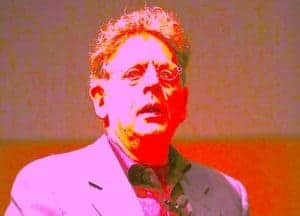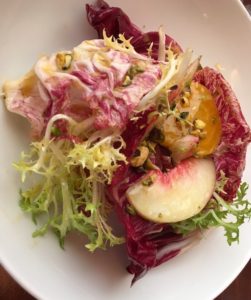Carmel without fog, exciting new opera, and a dinner of sophisticated comfort food. What an afternoon! Thanks to the innovative Days and Nights Festival that is one of the West Coast laboratories for friends and colleagues of composer Philip Glass (image: Chad Buchanan), we were on our way to a matinee performance of Glass’ jewelbox chamber opera In the Penal Colony. Story by Kafka, crystalline music by Glass, production by Brian Staufenbiel and chamber orchestra conducted by Nicole Paiement, of Opera Parallele.
On a day warm enough to be called “hot” we parked and walked down into the heart of Carmel by the Sea, oozing visitors, designer canines, and toybox boutiques and found our way to the restored 1929 Golden Bough Playhouse.
The pretty theater on one of those oh so Doris Day residential streets in this landmark town was open for ticket holders to the final day of Glass four-day arts festival. Having worked with the Opera Parallele founders when they were in residence at UC Santa Cruz, we were familiar with the style of performance.
Projected and devised scenic design by David Murakami of what Staufenbiel described to us as “deconstructed animation,” the stage already contained the prisoner of Kafka’s absurdist story. Wrapped in gauze, the figure lay at the center of the Golden Bough’s revolving double stage. Staufenbiel moved his small ensemble effectively within the encircling space, creating non-stop momentum of story and music. The outer circle became the main platform for the table, chair, and ultimately the execution “machine”—a gorgeous assemblage of casket, and shimmering chandelier of lethal spikes, created by Noah Kramer. To the right of the stage, Paiement and her quintet of strings waited to begin what would be a brisk, riveting hour and a half of quintessential Philip Glass orchestration pushing against the gorgeous arias sung by Robert Orth and Javier Abreu, as the Officer and the Visitor.
Like most Glass operas, this one pried open the bloody heart of side-street existentialist themes. Forcing the audience to confront the paradoxes of alleged civilization, surfed on endless variations of Glassian arpeggios.
After the performance Katya and I congratulated Paiement, who introduced us to the composer—a gracious and rumpled 80something—before everyone hit the foyer for wine, cookies, and schmoozing.
On the drive back to Santa Cruz the air grew distinctly smoky. And smokier. A quick call from the car determined two things: a fire in Bonny Doon that was small, and another fire in Solano County that was not small. Smoke from the Solano fire lent ominous beauty to the fields and estuaries near Moss Landing and Corralitos.

Dinner was waiting at La Posta, in midtown Santa Cruz, where chef Katherine Stern showed once again that her conceptual grasp of seasonal flavors keeps stride with the reigning culinary zeitgeist. In New York several weeks ago I had noticed the prevalence of wild herbal flavors and sauces, e.g. sorrel and nasturtium in mains as well as desserts. At La Posta we began with a shared salad of rose-colored chicories, luscious burrata, a few slices of nectarine, a yellow beet, and a dusting of toasted pistachios. Early autumn in every bite.
 Katya’s entree was a Fogline Farms chicken breast stuffed with spinach and ricotta, sliced into plump cylinders on a bed of leeks and crispy roast brussels sprouts. My entree was a cittarra spaghetti tossed with housemade Italian sausage, loaded with fennel, Early Girl tomatoes, and spicy red chiles. A dazzling pasta, which is exactly what I expect of La Posta.
Katya’s entree was a Fogline Farms chicken breast stuffed with spinach and ricotta, sliced into plump cylinders on a bed of leeks and crispy roast brussels sprouts. My entree was a cittarra spaghetti tossed with housemade Italian sausage, loaded with fennel, Early Girl tomatoes, and spicy red chiles. A dazzling pasta, which is exactly what I expect of La Posta.
More easy-to-love dazzle came in the form of an apple cornmeal cake,on a pool of fennel crema topped with quince mousse. Unexpected and resonant flavors combined in each bite. Apple, quince, fennel. A brilliant dish.
Then home to watch one of the last episode of The Forsyte Saga. How did we miss it the first time around?


